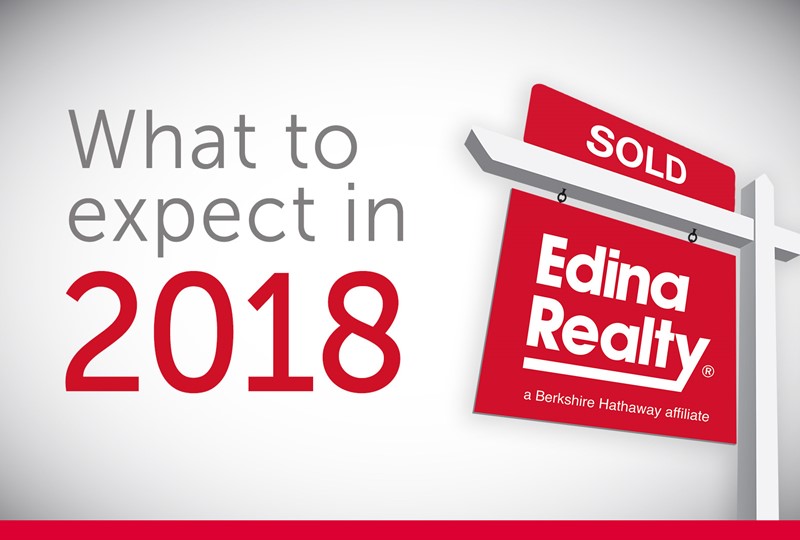
Key insights
- We expect that the Minnesota and Wisconsin housing markets in 2018 will look a lot like 2017
- We’ll see continued growth in new construction and a strong local economy
- The vast majority of Minnesota and Wisconsin homeowners will still be able to take the tax deduction minimizing tax reform’s impact on local housing
Sharry Schmid, president, Edina Realty
As president of Edina Realty, Sharry Schmid provides guidance and direction to nearly 2,500 REALTORS®.
With 2017 nearly in the books, many people are wondering what’s ahead for real estate in 2018. While I don’t have a crystal ball, current market trends and the state of the local economy can help inform some predictions for what’s to come. But before I get started, let’s take a look back at 2017.
2017 often brought challenges for entry-level buyers, who found themselves competing over a limited supply of homes in lower price points. The competition fueled an increase in prices and often meant a fast sale and closing for sellers, but left some buyers extending their rental agreements and reconsidering their must-haves for home shopping. Overall, the lack of supply left 2017 looking and feeling a lot like 2016—both of which were strong and active markets that saw price increases and low mortgage rates.
We expect that the Minnesota and Wisconsin housing markets in 2018 will look a lot like 2017, but could be impacted by tax reform. Whether you’re buying, selling or just like to keep up with the housing market, here are insights you can use as we enter a fresh new year.
2018 housing snapshot
- 2018 will be much like 2017, with moderate home price appreciation, which may slow slightly by the middle or end of the year. Unlike during the “bubble years,” low inventory, low interest rates and strong buyer demand continue to be the driving forces for price growth—which finished the year up about 6.5% over 2016, according to the Minneapolis Area Association of REALTORS (MAAR).
- Mortgage loan interest rates are expected to increase and could potentially rise to around 5 percent for a 30-year fixed loan. Nevertheless, they will remain well below the long-term average of around 8 percent (MAAR).
- Inventory will continue to be a challenge, especially at lower price points. However, we could see new construction pick up some of the slack for move-up buyers whose price points reside around $350K or above.
- Speaking of new construction, the Builders Association of the Twin Cities estimates that building permits were up by as much as 30 percent in November of 2017, with continued growth expected for 2018.
- The market will likely continue to tell two different stories. Lower price points will experience lower inventory, greater demand and higher price increases while upper bracket homes, which have fewer qualified buyers and are generally considered to be $500K and above, will see more moderate conditions.
Local economy
- According to a new study from USA Today, Minnesota is the best-run state in the nation based on several factors, including:
- Strong fiscal management—The state has saved 10% of its annual budget, compared with a national average of 8%
- Low employment—Minnesota’s unemployment rate has been below 4% for 40 consecutive months and recently hit 3.3%. The national rate is 4.1%
- Above average median household income—$65,599 ($8K more than national median income)
- Rent prices continue to rise as only 5% of apartments are vacant
- Minnesota also consistently ranks high among the best states for business, and has topped lifestyle lists, health lists and more. This all bodes well for housing; a well-paid, healthy and optimistic consumer is better able and more likely to invest in a home and their community.
A developing story
As I mentioned earlier, tax reform and a cap on mortgage interest deductions for primary and secondary residences may be a factor in 2018’s housing market. However, the lower cap of $750K (down from $1 million) will still allow the vast majority of Minnesota and western Wisconsin homeowners to take the deduction. Regardless of tax reform, we know that owning a home means much more to people than a yearly tax deduction, and the health of the local economy will continue to shepherd strong activity in the market.
Need a real estate expert?
If you’re preparing to buy or sell in 2018, Edina Realty has around 2,500 REALTORS® in nearly every neighborhood across Minnesota and western Wisconsin. Reach out now to get connected with an expert you can trust.
Wondering what’s really involved with selling your home? Download your free home selling guide!









 ©2025 Prosperity Home Mortgage LLC®. (877) 275-1762. 3060 Williams Drive, Suite 600, Fairfax, VA 22031. All first mortgage products are provided by Prosperity Home Mortgage, LLC®. Not all mortgage products may be available in all areas. Not all borrowers will qualify. NMLS ID #75164 (For licensing information go to: NMLS Consumer Access at
©2025 Prosperity Home Mortgage LLC®. (877) 275-1762. 3060 Williams Drive, Suite 600, Fairfax, VA 22031. All first mortgage products are provided by Prosperity Home Mortgage, LLC®. Not all mortgage products may be available in all areas. Not all borrowers will qualify. NMLS ID #75164 (For licensing information go to: NMLS Consumer Access at